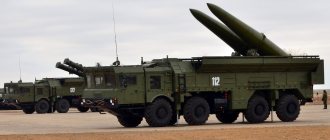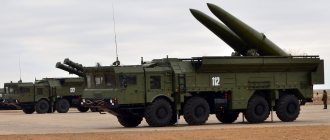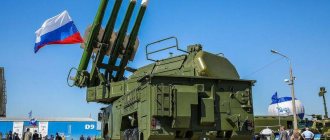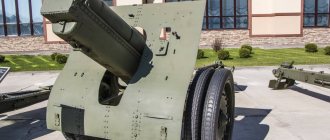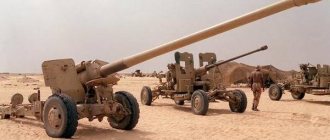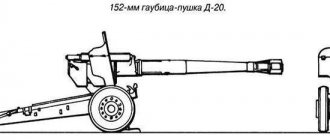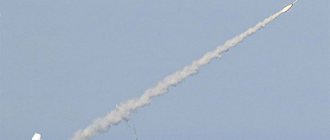05/16/2019 Category: Missile forces and artillery
- 2 Main tasks of missile forces and artillery
- 3 History of creation
3.1 Formation of troops in the USSR
- 3.2 Russian missile forces and artillery
Main tasks of missile forces and artillery
Missile forces and artillery are a branch of the ground forces that are the main means of fire defeating the enemy during combat operations and special operations. Rocket troops and artillery perform the following tasks:
- gaining and maintaining fire superiority over the enemy;
- causing damage to enemy personnel, strategic weapons and equipment;
- destruction of control systems for troops, equipment, and weapons;
- destruction of defensive structures and, if necessary, strategic infrastructure facilities;
- causing damage to reserve units and rear areas;
- weakening the second echelons and preventing the approach of enemy reinforcements;
- destruction of heavy military equipment: tanks, armored personnel carriers and other armored vehicles;
- fire support and cover for the retreat of allied forces;
- combating the landing of enemy airborne troops;
- light support during combat operations in the dark;
- smoke formation of enemy positions;
- use of projectiles with propaganda materials.
Strategic Missile Forces
In the Russian Federation, the Strategic Missile Forces (RVSN) are on constant combat duty - a separate branch of the Armed Forces of the Russian Federation, the main component of Russia's strategic nuclear forces. In addition, formations and military units of missile forces and artillery are organizationally included in various types and types of troops:
- missile forces and artillery of the Russian Ground Forces;
- missile forces and artillery of the Coastal Troops of the Russian Navy;
- artillery of the Russian Airborne Forces;
- artillery of the Border Service of the FSB of Russia;
- artillery of the Russian National Guard troops.
Missile forces include formations and military units of operational-tactical and tactical missiles, large-caliber rocket artillery. Artillery consists of formations and units of howitzer, cannon, rocket artillery (mortars), as well as control, artillery reconnaissance, and support units.
The combat capabilities of missile forces and artillery depend on the coherence of reconnaissance, equipping with advanced weapons, automating the processes of reloading and preparing guns, as well as increasing the firing range and firing accuracy. According to military doctrine, missile forces and artillery cause the main damage to the enemy during combat operations. This branch of the military also has the ability to use weapons of mass destruction. Most artillery weapons were developed during the Cold War and continue to be used and modified. Well-known systems: “Grad”, “Smerch” and “Hurricane” were used during the war in Afghanistan, showed excellent results in two Chechen campaigns and are considered a reliable and highly effective type of weapon. The Strategic Missile Forces have in their arsenal intercontinental ballistic missiles, both with nuclear warheads and conventional explosives. They can, if necessary, strike anywhere on the globe.
Strategic Missile Forces mission
At the beginning of their appearance, the role of nuclear weapons was assigned exclusively as an offensive weapon and to gain an advantage in military terms. In today's reality, this is more of a political means to move towards a goal, restraining aggressive opponents.
However, the deterrent factor is not only the global weapons themselves, but the presence of actual combat characteristics and wide possibilities of use in any situation.
With universal reach, colossal destructive power and without incurring unaffordable maintenance costs, strategic nuclear forces provide effective deterrence at lower costs. In relation to states with superior economic, quantitative resources and the level of equipment of troops with the latest highly effective conventional weapons.
The Strategic Missile Forces, with their daily combat readiness, provide our country with the opportunity to carry out a long and economically difficult reformation period of the Armed Forces and the entire military organization of the Russian Federation.
The purpose of the Strategic Missile Forces is to provide nuclear deterrence of alleged attacks and retaliatory attack actions with their own or general forces of strategic purpose, with the execution of a large-scale, group and single nuclear missile strike on enemy targets of strategic purpose, which play a key role in the combat capability of the opposing side.
These objects can be located together or separately, at a significant distance. In addition, the task is to implement nuclear deterrence. In modern times, a powerful nuclear shield and the mobile systems that complement it seem to be a significant argument for nuclear deterrence and the preservation of international stability.
History of creation
Humanity began launching rockets almost immediately after gunpowder was invented. Even in Ancient China, cases of combat use of this weapon were recorded, but due to the imperfection of technical equipment, it was difficult to call such a weapon effective. In the 19th century, the British Army began using Congreve missiles, which remained in service with Her Majesty's troops for several decades. They lacked accuracy, so with the advent of barreled artillery weapons, rockets were removed from service.
Formation of troops in the USSR
Later, when the First World War ended, several countries began developing and experimenting with jet weapons. Russia succeeded in this matter, and by the beginning of World War II, the BM-13 installation, better known as “Katyusha,” was put into service.
Installation of BM-13 Katyusha
The first ballistic missiles that were in service in the USSR were captured developments by German designers. The missiles did not have a long flight range and served only to perform ordinary tasks. The first intercontinental ballistic missile (ICBM) of the USSR was the R-7. It boasted a range of 8,000 km and was first launched in 1957. At the same time, with its help, the first artificial satellite of our planet was launched into orbit. In the 1960s, emphasis was placed on developing intercontinental ballistic missiles that were launched from launch silos located underground.
At the same time, work is underway on rocket artillery. Thus, in 1963, the BM-21 Grad was put into operation, which is still in service with the Russian army today. At the end of the 60s, work began on the “flower” series of self-propelled artillery units: “Peony”, “Gvozdika” and “Acacia”. They are still in service with the Russian army today.
In the late 70s, the Strategic Missile Forces received intercontinental ballistic missiles with multiple warheads, which significantly increased their combat capabilities. On December 30, 1975, the R-36M, better known as “Satan,” was adopted, which was recognized as the most effective strike force of the strategic missile forces of the USSR, and later the Russian Federation.
In the same year, the Tochka missile system was released.
Missile complex Tochka
In 1987, the Smerch MLRS was adopted. By the way, it was “Smerch” that was recognized as the most powerful system of its time, and held this position for several years.
Russian Missile Forces and Artillery
After the collapse of the Soviet Union, most of the military potential became the property of Russia. The ICBMs were quickly transported to the territory of the Russian Federation, and the launch silos that remained on the territory of other CIS countries were destroyed. In 1996, the Russian Strategic Missile Forces received the first stationary Topol-M complex, which is a fifth-generation ICBM. Despite economic difficulties, Russia is re-equipping its missile forces. Outdated ICBMs are being replaced by modern Topol-M and Yars, and work is also underway on a liquid-propellant rocket called Sarmat. In 2010, an agreement was concluded between Russia and the United States regulating the number of nuclear missiles, as well as their carriers (SALT-3). The document states that each country has the right to keep in service no more than 1,550 nuclear warheads and only 770 delivery vehicles. The latter include not only ICBMs, but also strategic aircraft, as well as missile-carrying submarines. The treaty also provides for a ban on the production of missiles with multiple warheads, but this does not mean that countries cannot develop new technologies in this area.
Missile carrier submarine
“Respond effectively to any challenge”
Currently, the Strategic Missile Forces are the main component of Russia's strategic nuclear triad. The structure of this type of troops includes three missile armies, uniting 12 divisions. Four formations are equipped with silo-based missiles, eight - with mobile systems.
Also, Strategic Missile Forces military personnel use the infrastructure of the Plesetsk cosmodrome of the Ministry of Defense (Arkhangelsk region), the 4th state central interspecific training ground Kapustin Yar (Astrakhan region) and some sites of the 10th test site Sary-Shagan (Kazakhstan).
Also on topic
Large-scale potential: how large-capacity warships of the new generation will strengthen the Russian Navy The basis of the presence of the Russian Navy in the World Ocean in the future will be the latest large-displacement ships. About it…
The Strategic Missile Forces' arsenal includes about 60% of the Russian army's nuclear weapons and nuclear warheads. There are about 400 ground- and stationary-based ICBMs on combat duty. More than half of them were involved in the Thunder 2019 command post exercises, held in October under the leadership of Russian President Vladimir Putin.
According to the commander of the Strategic Missile Forces, Colonel General Sergei Karakaev, today there are seven types of ICBMs in service, “allowing you to effectively respond to any challenges.”
“Among them are four types of stationary (mine)-based missile systems: Voevoda, Stiletto, Topol-M and Yars. The mobile-based group includes the Topol, Topol-M and Yars mobile ground-based missile systems,” Karakaev said in a December interview with Krasnaya Zvezda.
In 2024, as the general expects, Soviet complexes (Stiletto, Topol, Voevoda) will be completely replaced by Russian-made ICBMs. In particular, in the coming years, deliveries to the troops of the latest RS-28 Sarmat missile, which has an almost unlimited range, will begin. The first recipient of these weapons will be the 62nd Uzhur Red Banner Missile Division (Krasnoyarsk Territory).
Re-equipment with universal solid-fuel ICBMs "Yars" and "Topol-M" will continue. They are inferior to the liquid Sarmat in terms of range (10-12 thousand km versus more than 20 thousand km) and payload (1-1.2 tons versus 10 tons), but are lighter and cheaper to produce.
- The mobile missile system enters field positions for combat duty in the Teikov missile division of the Strategic Missile Forces
- RIA News
Also, an important innovation in the Strategic Missile Forces will be the equipping of Avangard hypersonic units, which, according to the Russian Ministry of Defense, are almost impossible to intercept by missile defense systems. By the end of the year, the first formation armed with this complex will take up combat duty.
We are talking about the regiment of the 13th missile division of the Strategic Missile Forces (Dombarovsky, Orenburg region). The carrier of the Avangard will be the UR-100N UTTKh Stiletto, then the complexes will be installed on the Sarmat.
Vadim Kozyulin emphasized that ensuring the combat readiness of the Strategic Missile Forces has always been given priority by the state. Strategic Missile Forces remain the most important factor, “which negates the possibility of any large-scale aggression against the Russian Federation”
In addition, the combat potential of the Strategic Missile Forces involuntarily stimulates the negotiation process with the United States, the analyst believes.
“The global security architecture is largely based on the treaty framework on strategic weapons. There is an understanding of this not only in the Russian Federation, but also in the USA. For example, American experts from the Dartmouth Dialogue, which was recently held in Dayton, agree with this. Unfortunately, the contractual basis is now being destroyed. However, paradoxically, the modernization of the Strategic Missile Forces can benefit the negotiation process with the United States,” says Kozyulin.
In turn, in a comment to RT, the head of the department of political science and sociology of the Russian Economic University. Plekhanov Andrei Koshkin noted that for 60 years the Strategic Missile Forces have remained a key guarantor of Russia’s security. Moscow maintains strategic parity with Washington thanks to its high scientific and production potential and the professionalism of missile officers, the expert is sure.
Armament
The Russian Missile Forces are three armies, consisting of 12 divisions each:
- 31st (Orenburg).
- 27th Guards (Vladimir).
- 33rd Guards (Omsk).
It also includes the Central Command Post and the Main Headquarters of the Missile Forces.
The missile forces are armed with:
- 60 UR-100NUTTKH (320 warheads);
- 46 R-36M in various modifications (460 warheads);
- 72 "Topol";
- 78 Topol-M units;
- 49 Yarsov (196 warheads).
The complexes are ready to deliver 1,166 strikes on enemy territory.
The stationary and self-propelled artillery of the Russian Federation are armed with:
- 48 stationary tactical complexes "Tochka-U";
- 108 OTRK "Iskander";
- 150 units of self-propelled gun "Gvozdika";
- 800 self-propelled guns "Acacia";
- 100 self-propelled guns "Gyacinth-S";
- 300 self-propelled guns "Pion";
- 450 152-mm self-propelled guns "Msta";
- 50 self-propelled guns “Khosta” (modification of “Gvozdika”);
- 30 Nona-SVK self-propelled mortars;
The Russian army also has towed barrel artillery at its disposal:
- 100 Nona-K mortars;
- 4500 D-30A howitzers;
- 150 Msta-B howitzers;
- 500 MT-12 Rapier anti-tank guns.
Multiple launch rocket systems:
- 550 units of BM-21 "Grad";
- 200 pieces of BM-27 “Hurricane”;
- 100 BM-30 Smerch MLRS vehicles.
Mortars:
- Automatic mortar "Cornflower" - about 1000 units;
- 82-mm mortar “Tray” - 800 pcs.;
- Mortar complex "Sani" - 700 units;
- Self-propelled mortar "Tulip" - 430 units.
Constant attention is paid to the development of new equipment and types of ammunition, so it is possible that soon several new combat systems will be simultaneously adopted for service.
What do the Strategic Missile Forces consist of?
Structurally, the missile forces have not changed since the times of the USSR; they still consist of a missile army, which is divided into the same missile divisions and regiments.
For example, the 27th Guards Army of Vitebsk, which is controlled from Vladimir, has 5 missile divisions.
All components of the army are under the control of the main headquarters.
The most important location of the missile forces is in the Astrakhan region, namely at the Kapustin Yar training ground.
There is a missile testing site on the territory of Kazakhstan, it is called Sary-Shagan.
The center for scientific research and testing is located in Kamchatka, namely at the Kura training ground.
In addition to this, the missile forces also have:
- Central Institute for Research and Sciences No. 4;
- Academy training soldiers for the Peter the Great Rocket Forces;
- Military Institute of the Strategic Missile Forces in Serpukhov;
- Repair plants and storage bases;
- Airfields and heliports in the amount of 7 and 8 pieces;
- Engineering units that can do their job, camouflage missiles, clear the territory, build new paths;
Interesting Facts
- Most of the legendary Katyushas, which were used during World War II, were created on the basis of American Studebaker trucks. The reason is simple - the factories and factories evacuated to the rear did not have time to produce the required number of ZIS-6s, on which the BM-13 was originally installed. The United States supplied trucks to the USSR under the Lend-Lease program from 1942 to 1945.
- According to the Golitsyn Chronicle, the first artillery shots thundered on the territory of Rus' back in 1389, during the reign of Prince Dmitry Donskoy, and the first artillerymen were foreigners who were bought by Russians from abroad along with guns.
